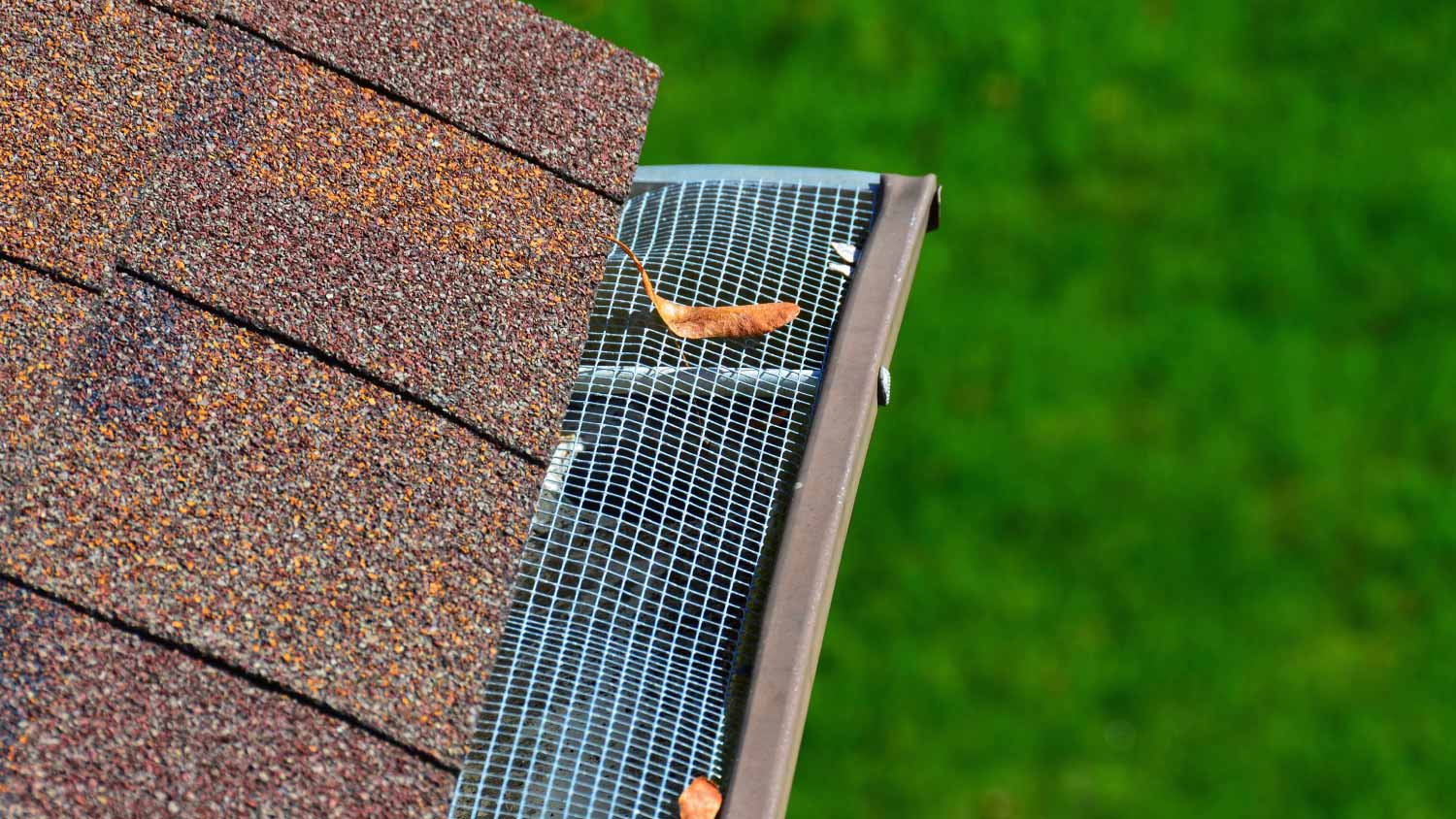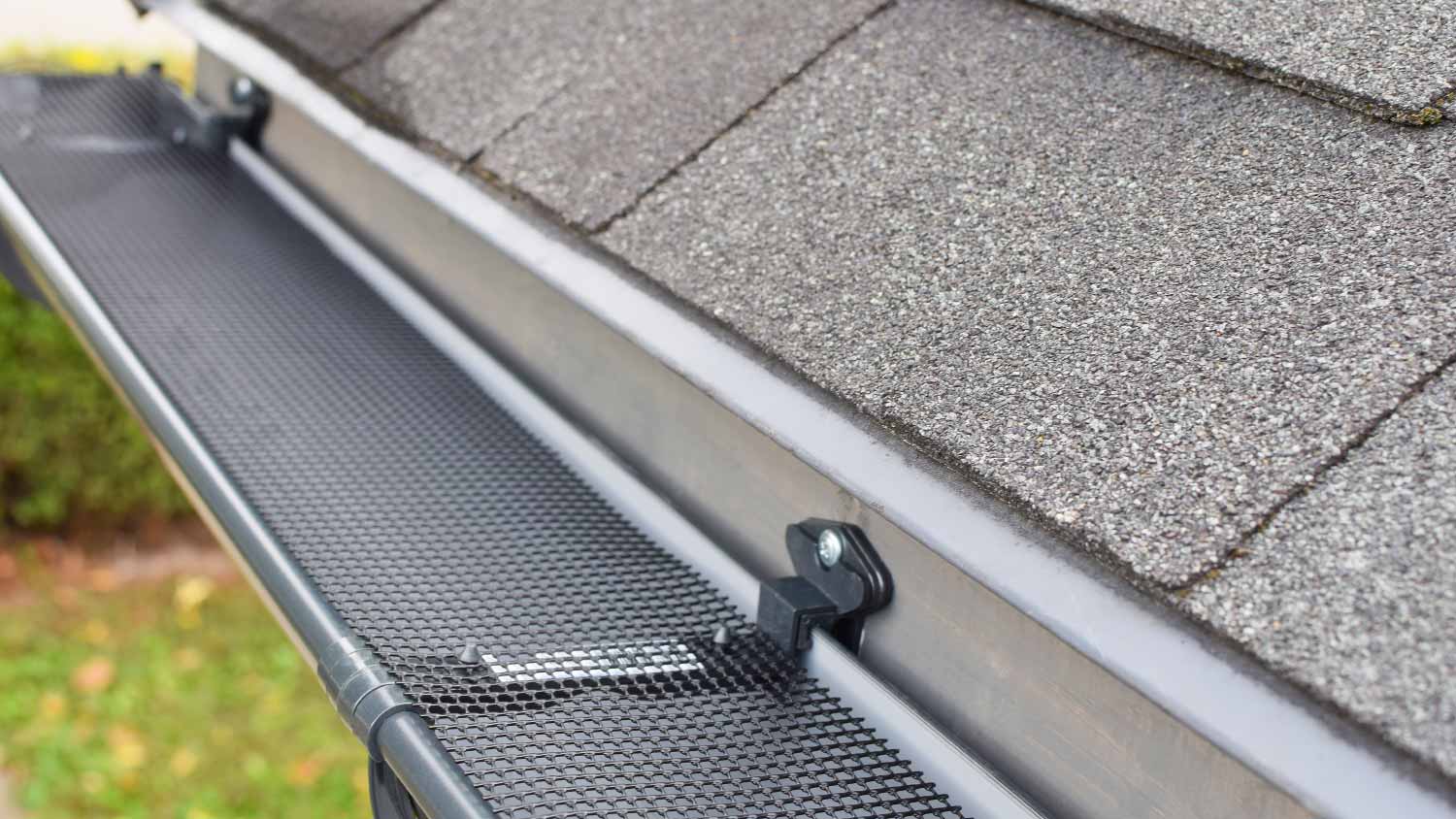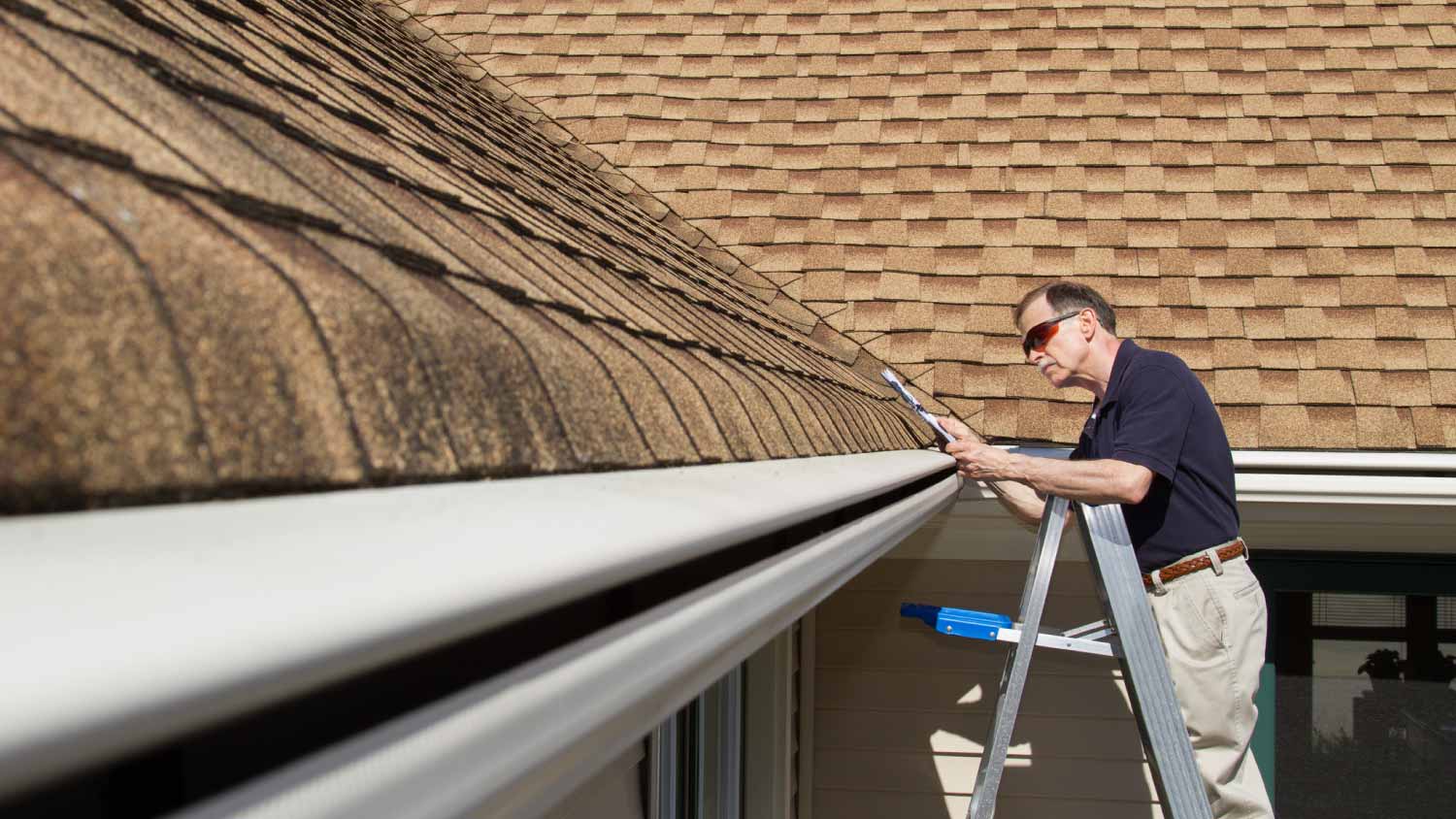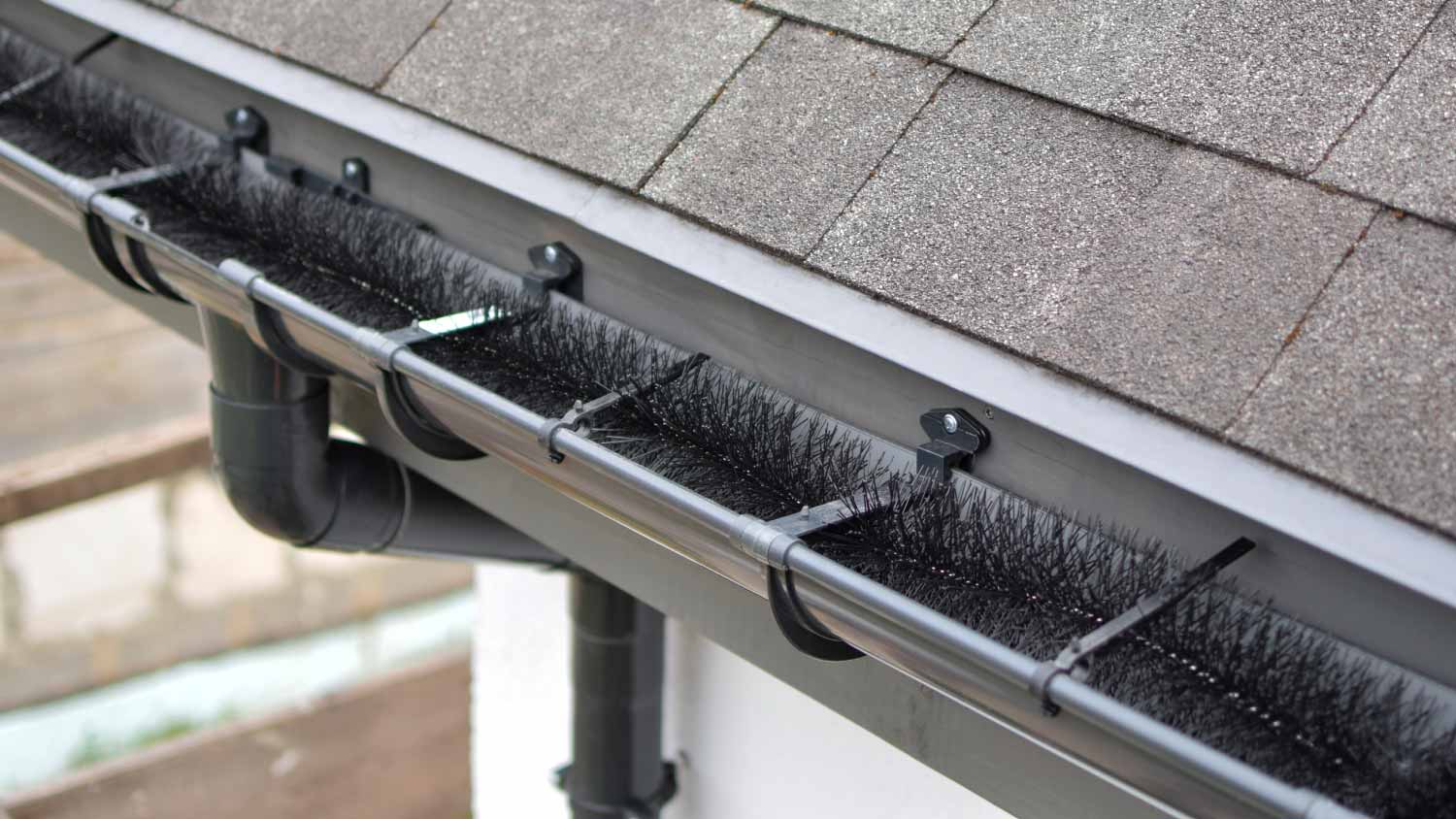
This guide will give you an idea of how much you can expect to pay when getting new seamless gutters installed when accounting for removal, labor, and different gutter materials.
These gutter guards get top grades for performance and quality


If you've noticed that your gutters frequently get clogged with leaves and other debris, adding gutter guards can help. There are several types of gutter guards to choose from, and cost, performance, and appearance are just some of the factors you’ll want to consider when shopping. This guide breaks down the pros, cons, and costs of six popular types of gutter guards.

Typical cost: $2–$7 per linear foot
In addition to being a long-lasting option, mesh provides a great way to keep larger debris out of gutters. For this reason, it's a top choice if you live in an area with heavy foliage. Another benefit is that it's very easy to brush debris away from the mesh after heavy storms deposit clumps of leaves and twigs at your gutters.
Pros:
Rugged
Good for harsh weather
Can last up to 20 years
Keeps debris out effectively
Low profile won't spoil curb appeal
Allows for water flow through gutters
Cons:
Not ideal for DIY installation
Some styles are expensive
Larger holes can require more maintenance

Typical cost: $2–$8.50 per linear foot
Micro-mesh gutter guards possess many of the same qualities as ordinary mesh gutter guards. With micro-mesh, the maximum size of the particles that can pass through the filter is much smaller. In addition to keeping out more debris, micro-mesh gutter guards are actually more attractive because the holes are so tightly compacted that they are nearly invisible.
Micro-mesh gutter guards are typically made of stainless steel, aluminum, or plastic. People like micro-mesh gutter guards because they are a long-lasting, inconspicuous option that can keep out large amounts of debris in rugged weather conditions.
Pros:
Can last 20 to 30 years
Very durable in harsh climates
Keep out debris of all sizes
Great for directing water flow from your foundation
Cons:
Require annual cleaning and maintenance
Costs more than other options
Professional installation is required

Typical cost: $1–$2.50 per linear foot
The concept behind screen gutter guards is similar to the concept behind the screens we use on our windows. These screens have large holes that keep debris out while still allowing for air and water flow. Screen gutter guards can be placed directly on top of your old gutters without any complex retrofitting. You do need to be diligent about having screen guards cleaned at least once per year to avoid problems. Cleaning this type of gutter guard requires you to remove each screen.
Pros:
Affordable
Great for blocking larger debris
Can typically be done with either DIY or professional installation
Cons:
Larger holes can allow some debris to pass through
Screens must be removed and cleaned at least once annually

Typical cost: $3.50–$7
This clever design allows water to flow around your guard to get to the gutter. While water can flow freely, debris is cut off in its tracks. You don't have to worry about debris piling up at the block-off point because reverse-curve gutter guards actually make it easy for debris to simply trickle down.
While this is an innovative choice, it's not necessarily an aesthetic choice. You'll need to be okay with having noticeable leaf guards if you select this option. Installation is also complex. During installation, it's necessary to lift roof shingles.
Pros:
One of the best for allowing proper water flow
Allow debris to slide down without clumping
Great for blocking large debris
Cons:
Requires professional installation
Can damage the roof if installed incorrectly
Alters the appearance of your home
More expensive than many other options
Typical cost: $1.50–$3 per linear foot
Foam can be a good budget option if you're looking for a simple fix for clogged gutters. Foam gutter guards essentially slip right into the gutter without the need for a custom fit.
While foam is often touted as being a great budget pick, the reality is that it comes with some hidden costs. Unlike options that last 20 years, foam gutter guards can start to deteriorate after just a few seasons. They are also a little bit difficult to clean because they need to be removed and replaced every time you clean out your gutters. Finally, foam isn't necessarily the best material for helping debris to channel through your gutters. In fact, debris will generally just pile on top of foam. This can damage both your foam gutter guards and your actual gutter system.
Pros:
Affordable
Quick DIY installation
Can fit essentially any gutter style
Cons:
Removing foam for cleaning is a time-consuming task
Debris will pile on top of foam
Not the best for allowing air and water to flow through gutters

Typical cost: $3–$6 per linear foot
As the name suggests, a brush gutter guard looks exactly like a large-bristled brush that rests inside your gutter. When inserted into gutters, it can look like a fuzzy caterpillar. The open-air design of this type of gutter guard is great for allowing air and water to pass through. However, the "spiny" quality of the brush gutter guard prevents debris from getting through.
Brush gutter guards excel at blocking pinecones, leaves, and other types of large debris. However, fine particles can often get through. This includes pine needles and small twigs. Once these materials get tangled up in a brush gutter guard, they can be difficult to remove.
Pros:
Easy to install
Easy to replace
Easy to remove for cleaning
Allows for good air and water flow
Cons:
Not that affordable when considering performance
Smaller particles can stick to the brush
Clogs easily
Requires ongoing maintenance
The various gutter guard materials each have their own pros and cons—some are more durable than others, while some have the benefit of being more cost-effective.
1. Plastic: Plastic gutter guards are a budget-friendly option, but they’re much less durable and have shorter lifespans than gutter guards made from metal. In addition, the mesh screens and drainage openings on plastic guards are less precise and can prevent water from filtering properly.
2. Aluminum: Aluminum is one step up from plastic—it’s more durable, has a longer lifespan, and is corrosion-resistant. It doesn’t last as long as steel, but it is a cost-effective option.
3. Stainless steel: Stainless steel is the strongest, most durable gutter guard material you can choose. Some premium brands will manufacture gutter guards with marine-grade stainless steel, which is also known as surgical-grade stainless steel. Made from an alloy of molybdenum, nickel, and chromium, marine-grade stainless steel is resistant to erosion. This material is also more precise; because steel is stronger than plastic or aluminum, the mesh screens can be made finer and can therefore catch more debris while allowing good water flow.
With so many types of gutter guards out there, it can be hard to find the best option for your home. If you're in a pinch, foam and brush gutter guards can be good for quickly getting guards in place to prevent serious damage to your gutters. If you're looking for a long-term solution, mesh, micro-mesh, and reverse-curve gutter guards are considered the premium options. While mesh and micro-mesh are great for creating "invisible" protection, reverse-curve gutter guards deliver added innovation if you're ready to accept the fact that your guards will be more visible.
It's important to know that gutter overflow is a serious problem that can eventually ruin your home's roof or foundation. Gutter guards are worth the cost if you live in an area that experiences a lot of rainfall and is heavily wooded, which is the perfect combination for many weekends spent cleaning out gutters.
You can certainly have success with DIY gutter guards. However, homeowners should consider a few things before making a decision. Improper installation could be giving you a false sense of security while excessive water damage is slowly cracking your home's foundation. What's more, improperly installed guards can actually put pressure on your gutters until they begin to sag or pull away from your home. Finally, damaging your gutters or roof while installing DIY gutter guards could void warranties.
Most local gutter installers also install gutter guards. They can offer you access to high-quality products with warranties. What's even more important is that they can ensure an expert-level installation that's going to keep your gutters protected for years to come. This can save you from a pricey and unexpected gutter replacement cost down the line. Pros can even make custom recommendations based on the style, age, and positioning of your home.
From average costs to expert advice, get all the answers you need to get your job done.

This guide will give you an idea of how much you can expect to pay when getting new seamless gutters installed when accounting for removal, labor, and different gutter materials.

Here's everything you ever wanted to know about saving money by installing faux copper gutters instead of real copper gutters.

Heated gutters are a great way to minimize gutter damage and maintenance. Use this guide to estimate your heated gutter cost before getting started.

Learn about the different types of gutters that can be installed at different price ranges to stop water damage to your home's foundation.

Learn about the different types of rain barrels and how to choose the best gutter rain barrel to collect rainwater at your home.

Foam gutter guards protect homes in warmer climates but aren’t as effective in the cold. Take a look at their pros and cons to see if they’re right for you.